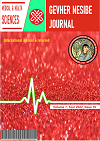The Effect of Mesenchymal Stem Cells on Capsule Formation around Silicone Implant in Rats
DOI:
https://doi.org/10.46648/gnj.302Keywords:
Adipose tissue, Breast implant, Capsular contracture, Mesenchymal stem cellAbstract
ABSTRACT Objective: Capsular contracture is a common adverse effect of breast augmentation and reconstruction surgeries. In the present study we evaluate the effect of adipose tissue-derived mesenchymal stem cells on the capsular structure following breast implant surgery. Materials and Methods: Included in the study were 16 female Wistar-Albino rats, who were divided randomly into two groups. Silicone implants were placed subcutaneously in the pectoral region of the animals in the sham group, while 1 cc of approximately 40 million adipose tissue-derived stem cells were injected into the suture gap after the placement of silicone implants in the experimental group. All experimental animals were re-operated under the same conditions at postoperative week 12 and the implants were removed. All operations were performed by the same surgeon. The capsular structure that had formed around the implants was examined volumetrically and immunohistochemically. Results: Immunohistochemically, the presence of a thick fibrous capsule and prominent procollagen in the periphery was detected in the control group, while capsular staining was noted in the experimental group, wherein thin collagen fibers were organized with the appearance of loose connective tissue, while procollagen staining was lighter and scattered. A volumetric comparison revealed the mean capsule volume to be statistically significantly lower in the experimental group than in the control group. Conclusion: The administration of adipose tissue-derived stem cells resulted in the development of a soft capsule and the formation of new vessels around the implant, and so is likely to have effects that may reduce the development of capsular contracture following breast silicone implant surgery.
Downloads
Published
How to Cite
Issue
Section
License

This work is licensed under a Creative Commons Attribution-NonCommercial 4.0 International License.


